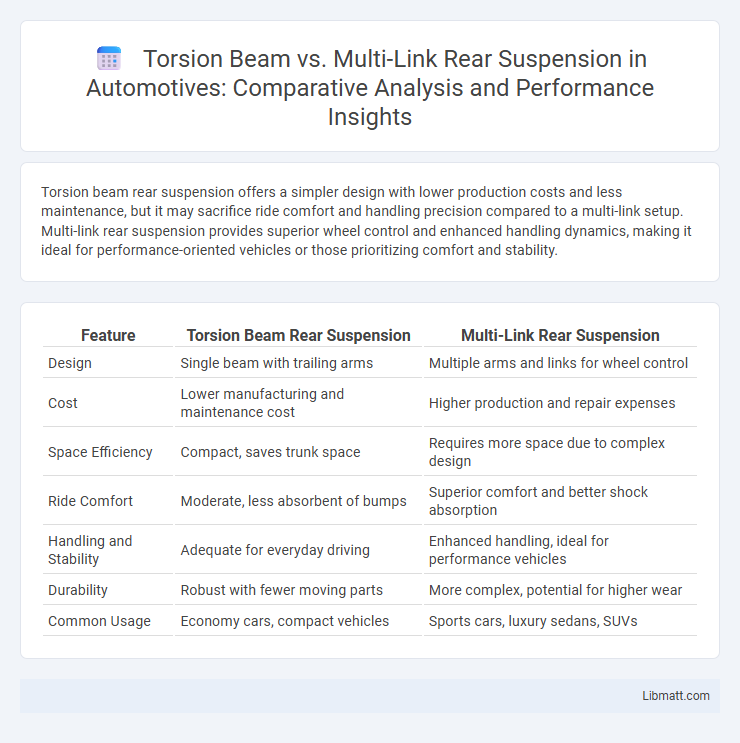Torsion beam rear suspension offers a simpler design with lower production costs and less maintenance, but it may sacrifice ride comfort and handling precision compared to a multi-link setup. Multi-link rear suspension provides superior wheel control and enhanced handling dynamics, making it ideal for performance-oriented vehicles or those prioritizing comfort and stability.
Table of Comparison
| Feature | Torsion Beam Rear Suspension | Multi-Link Rear Suspension |
|---|---|---|
| Design | Single beam with trailing arms | Multiple arms and links for wheel control |
| Cost | Lower manufacturing and maintenance cost | Higher production and repair expenses |
| Space Efficiency | Compact, saves trunk space | Requires more space due to complex design |
| Ride Comfort | Moderate, less absorbent of bumps | Superior comfort and better shock absorption |
| Handling and Stability | Adequate for everyday driving | Enhanced handling, ideal for performance vehicles |
| Durability | Robust with fewer moving parts | More complex, potential for higher wear |
| Common Usage | Economy cars, compact vehicles | Sports cars, luxury sedans, SUVs |
Introduction to Rear Suspension Systems
Rear suspension systems like torsion beam and multi-link play crucial roles in vehicle stability, handling, and ride comfort. Torsion beam suspension offers a simpler, cost-effective design with limited independent wheel movement, often used in compact and economy cars. Multi-link suspension employs multiple arms for each wheel, enhancing independent wheel motion, improving traction, and delivering superior ride quality in performance and luxury vehicles.
What is a Torsion Beam Suspension?
Torsion beam suspension is a type of rear axle design that uses a solid beam connected to the vehicle's chassis with flexible rubber bushings, providing a simple and cost-effective solution for rear wheel alignment and stability. It offers fewer moving parts compared to multi-link suspensions, resulting in less maintenance and a compact design suitable for smaller cars. Your choice between torsion beam and multi-link suspension affects ride comfort, handling precision, and overall vehicle dynamics.
What is a Multi-link Rear Suspension?
A Multi-link rear suspension consists of multiple arms or links that independently control wheel movement, enhancing ride comfort and handling precision. Unlike the torsion beam suspension, which uses a single beam connecting the wheels, the multi-link setup allows for better wheel alignment and improved traction on uneven surfaces. Your vehicle benefits from increased stability and superior performance, especially during cornering and dynamic driving conditions.
Key Differences Between Torsion Beam and Multi-link
Torsion beam and multi-link rear suspensions differ primarily in complexity, ride quality, and handling capabilities. Torsion beam suspension uses a simple beam that twists to absorb road shocks, offering durability and lower cost but limited wheel independence and less refined handling. Multi-link suspension features multiple arms allowing each wheel to move independently, enhancing ride comfort, better traction, and improved cornering performance, which may benefit your driving experience depending on your vehicle needs.
Ride Comfort: Torsion Beam vs Multi-link
Multi-link rear suspension offers superior ride comfort compared to torsion beam systems by allowing each wheel to move independently, reducing road noise and vibrations transmitted to the cabin. Torsion beam setups, while simpler and more cost-effective, tend to compromise on smoothness due to their semi-independent nature, which can lead to a harsher ride on uneven surfaces. Your choice between these suspension types can significantly impact overall driving comfort, especially on rough or bumpy roads.
Handling and Performance Comparison
Torsion beam rear suspension offers simplicity and lower weight, resulting in cost-effective handling that suits compact and budget-friendly vehicles but may sacrifice some precision and ride comfort during aggressive cornering. Multi-link rear suspension provides superior wheel alignment control and independent wheel movement, enhancing traction, stability, and responsiveness for improved handling and performance in sporty and luxury vehicles. The multi-link setup excels in maintaining tire contact with the road on uneven surfaces, delivering better grip and more confident handling compared to the torsion beam design.
Cost and Maintenance Factors
Torsion beam rear suspension systems are generally more cost-effective to produce and maintain due to their simpler design and fewer moving parts, reducing overall repair expenses. Multi-link rear suspensions, while offering superior handling and ride comfort, often incur higher maintenance costs because of their complex geometry and numerous components that require regular inspection and replacement. The choice between torsion beam and multi-link setups largely depends on budget constraints and long-term maintenance considerations.
Space Efficiency and Design Flexibility
Torsion beam rear suspension offers superior space efficiency due to its compact and integrated design, allowing more trunk and cabin space by eliminating complex linkage components. Multi-link rear suspension provides greater design flexibility, enabling independent wheel movement and precise tuning for improved handling and ride comfort. The choice between torsion beam and multi-link systems hinges on balancing packaging constraints with dynamic performance requirements.
Common Applications in Modern Vehicles
Torsion beam rear suspension is widely used in compact and subcompact cars due to its cost-effectiveness and simple design, providing adequate ride comfort for everyday driving. Multi-link rear suspension is commonly found in mid-range to luxury sedans and performance vehicles, offering superior handling, enhanced stability, and improved road grip. Both suspension types cater to different market needs, with torsion beams favoring economy and space efficiency, while multi-link systems emphasize dynamic driving and ride quality.
Which Rear Suspension is Better for You?
Choosing between a torsion beam and multi-link rear suspension depends on your driving needs and budget. A torsion beam suspension offers simplicity, lower cost, and durability ideal for everyday commuting and light loads, while multi-link suspension provides superior handling, ride comfort, and independent wheel movement, perfect for spirited driving or rough roads. Your decision should balance performance preferences with maintenance costs and vehicle type.
Torsion beam vs Multi-link rear suspension Infographic

 libmatt.com
libmatt.com